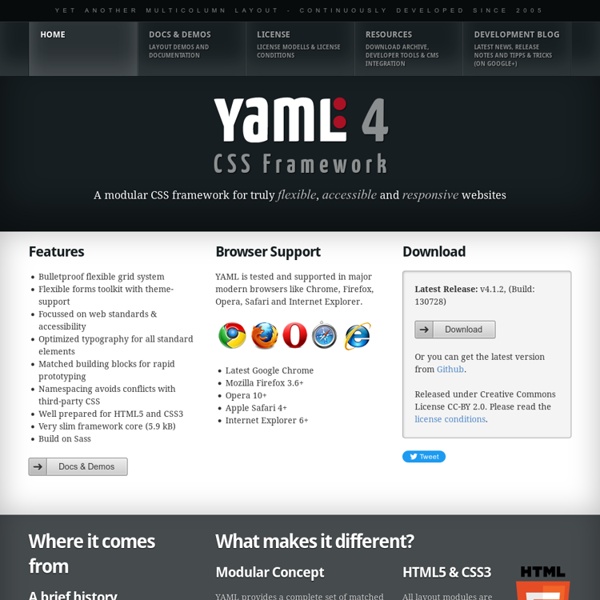ntent with Style - A CSS Framework
In my Modular CSS article I documented the possibility of breaking down stylesheets into components that could be reused across projects. All well and good. The next logical step is to extend this to become a CSS framework, allowing rapid development of sites with pre-written and tested components. All that's really required to produce this is a set of naming conventions and a flexible base template...
Style space: How to compare image sets and follow their evolution (part 4)
This is part 4 of a four part article. Part 1, Part 2, Part 3. Text: Lev Manovich. All visualizations are created with free open-source ImagePlot software developed by Software Studies Initiative.
Susy
All Susy3 API functions draw on the same shorthand syntax, which consists of two parts, seperated by the word of. The first part describes a grid-spanwidth, location (if needed), and spread (in any order): // <width> at <location><spread> $span: span(2);$span-spread: span(3 wide); // location is only needed with asymmetrical grids $span-location-spread: span(3 at 2 narrow);
New University of Utah center offers some serious computing muscle to handle 'extreme data'
SALT LAKE CITY — A picture may be worth a thousand words, but in the fields of science, they can be worth billions and billions of bytes of information. A few years ago, then Hewlett-Packard CEO Mark Hurd said "more data will be created in the next four years than in the history of the planet." Hurd's prediction was understated.
Foundation: HTML Templates
News or Magazine This template puts a focus on bold images, perfect for a magazine style site with eye catching content. Your stories are easy to find with large feature blocks.
Golden Grid System
GGS was my next step after Less Framework. Instead of a fixed-width grid, it used a fully fluid-width one, without even a maximum width. The resources it was published with are still available on GitHub. The idea was to take a 18-column grid, use the outermost columns as margins, and use the remaining 16 to lay elements out. On smaller screens the 16 columns could be folded into 8, 4 and 2. This behaviour was inspired by Massimo Vignelli's Unigrid system.
Famous Perl One-Liners Explained, Part I: File Spacing
Hi all! I am starting yet another article series here. Remember my two articles on Awk One-Liners Explained and Sed One-Liners Explained? They have received more than 150,000 views total now and they attract several thousand new visitors every week.
Building a Responsive Layout With Skeleton: Starting Out
Dave Gamache's Skeleton Boilerplate provides the perfect foundations upon which to build responsive websites rapidly and reliably. We're going to use Skeleton and build a responsive page based on the Magazine design featured on Webdesigntuts+ recently. We'll be looking at everything from multiple background images, through to media queries, flexible media and mobile-friendly navigation. Let's get started! First Steps In this first video we'll download the Skeleton Boilerplate and prepare our project.



